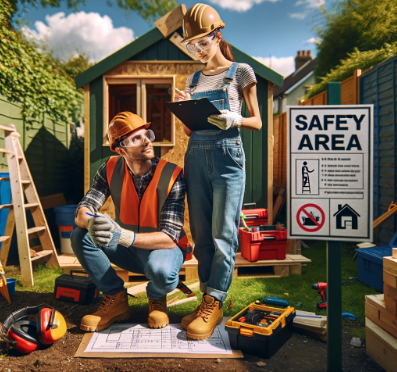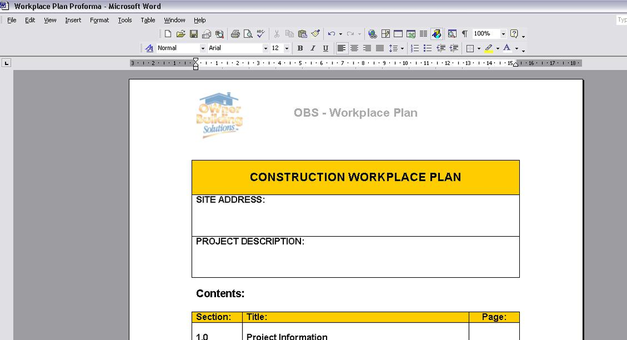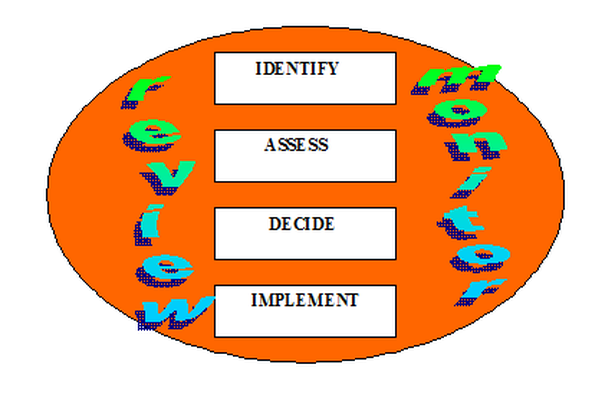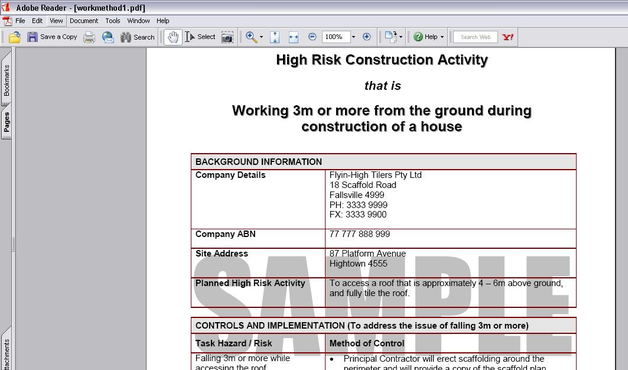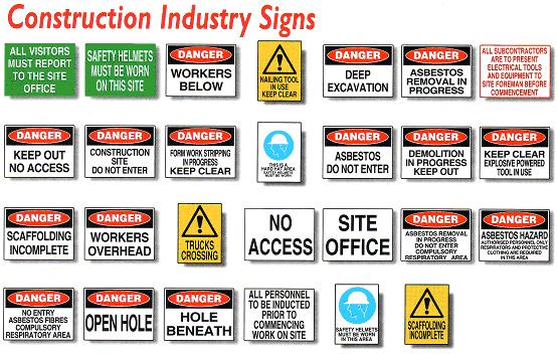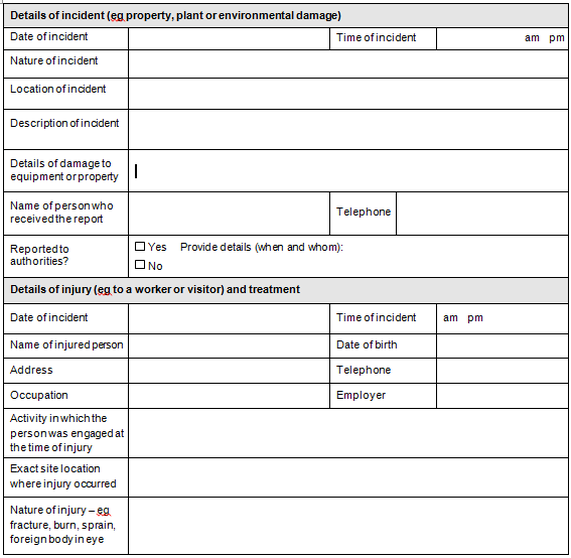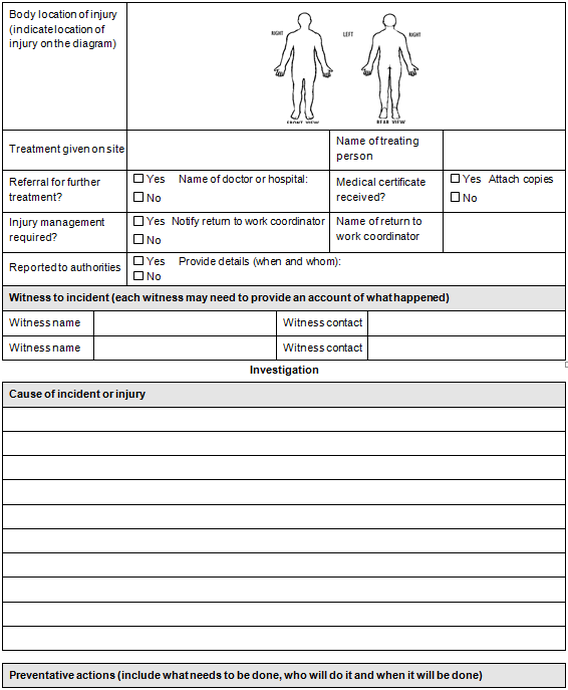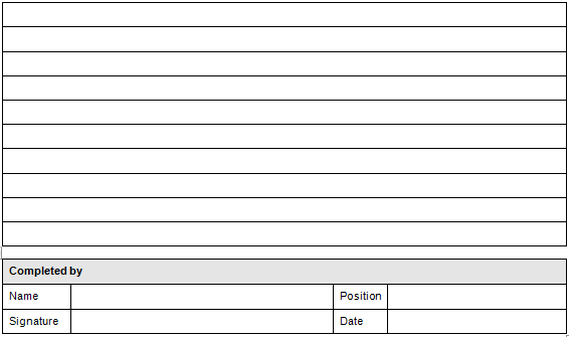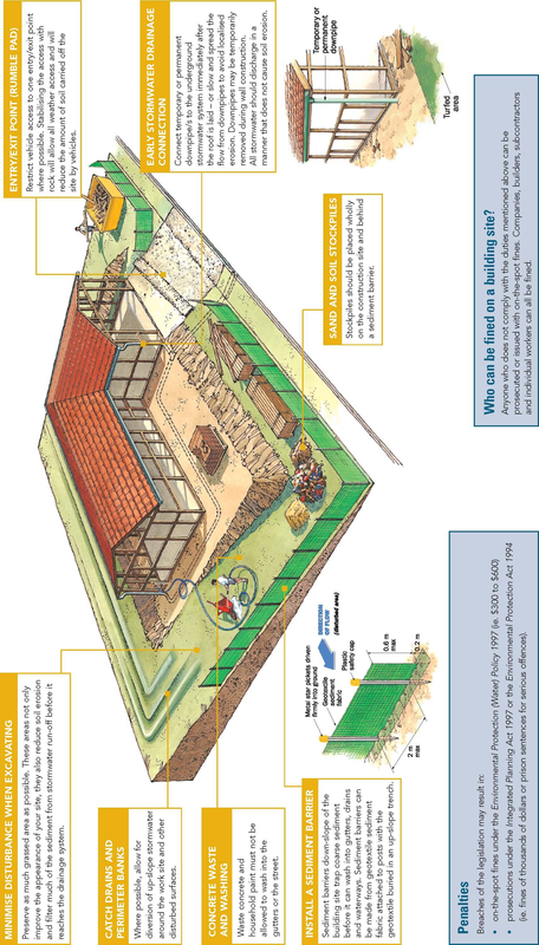8.0 WORKPLACE HEALTH and SAFTETY
Each year, hundreds of thousands of incidents, accidents and illnesses occur in Australian workplaces.
Many of the injury claims were made by workers aged 16 years or less.
The burden this places on workers, businesses and the community at large is enormous.
Direct financial costs arising from workers compensation, hospitalization, rehabilitation, lost production and staff retraining is estimated to cost the Australian community several billion each year.
For workers, the human cost of injury can be equally devastating.
Pain, discomfort and rehabilitation are often accompanied by other psychological stressors.
These typically include emotional stress, strained relationships, uncertainty and disruption to study.
Workplace injuries also affect or intrude into a persons social and recreation pursuits.
Family members are affected in similar ways.
Medical rehabilitation and social welfare payments are other costs absorbed by the community.
Overall workplace injury and illness undermines Australia’s economic performance and reduces our living standards.
Adapted from:
Department of Employment and Training Workplace Health and Safety Training Resource Kit
Introduction and Responsibilities
This section helps you to understand your responsibilities in the area of Occupational Health and Safety , particularly as they relate to owner-builders undertaking and managing their projects.
Whilst it remains true that no two workplaces or work sites are the same and that each circumstance has it’s own identifiable and inherent risks and hazards, the process and the methodology behind achieving a safe work environment remains constant across construction workplaces.
It is your responsibility as an owner-builder and therefore the person responsible for the worksite to:
- Recognise workplace hazards and risks
- Recognise appropriate control measures or strategies
- Contribute to establishing better controls
- Complete relevant workplace documentation in respect to OHS issues.
It further relates to the protection of the public from danger which could be present as a result of that work and the protection of the public and persons engaged in work activities as a result of plant, equipment, materials and other related sources.
Any workplace in Australia is governed by either Federal/Commonwealth or State legislation.
Legislation varies from state to state, but all are based on the National Standards developed by the National Occupational Health and Safety Commission (NOHSC), now commonly known as Worksafe Australia.
Each state or territory has it’s own specific department which enforces these laws.
History of Workplace Safety
Workplace Health and Safety Legislation has existed in varying forms for many years.
Originally our legislation was based on the English Factories Acts 1844 – 1894.
Australia inherited this style of occupational health and safety as a result of our influence and position as a member of the Commonwealth.
Today, Australia has adopted the Robens Model as the basis of it’s workplace health and safety legislation.
The emphasis is on proactive prevention, rather than reactive compensation.
The National Occupational Health and Safety Commission,
(WorkSafe Australia) has a “watch dog” role in seeing that all states and territories administer effective high quality Occupational Health and Safety practices, standards and legislation.
The commission is made up of Employer Associations, Union Representatives and State Government Representatives.
The group makes recommendations to the State Workplace Health and Safety Council, who will support the relevant Minister in the legislation of the Act.
Workplace Occupational Health and Safety Acts
All states and territories have their own independent but conforming legislation in place.
Broadly, these Acts are administered in the following manner, with only minimal variation being evident from authority to authority.
Workplace Health and Safety Council
The Minister takes advice from this council, consisting of Employer Organisations, Government Representatives, Unions and subject matter experts.
They meet to establish new laws, cades and practices for the various industries they represent.
A large function of the Workplace Health and Safety Council is to promote education in all areas of Health and Safety.
Administration of the Act
The legislation is administered by the Minister of the appropriate department responsible for OHS in each state or territory.
Workplace Health and Safety Industry Committees
The Minister establishes Industry Workplace Occupational Health and Safety Committees of independent expertise such as Building, Manufacturing or Aviation.
These committees advise the Workplace/Occupational Health and Safety Council on recommendations on changes and policy matters
Workplace Health and Safety Inspectors
These inspectors are employed by the Department and offer expertise in safety matters.
Inspectors have wide ranging powers to inspect workplaces and assist Workplace Occupational Health and Safety Representatives and Employers to improve safety standards.
Their duties include the investigation and reporting of workplace accidents, incidents and near misses.
These inspectors are employed by the Department and offer expertise in safety matters.
Inspectors have wide ranging powers to inspect workplaces and assist Workplace Occupational Health and Safety Representatives and Employers to improve safety standards.
Their duties include the investigation and reporting of workplace accidents, incidents and near misses.
Australian Standards
These standards are critical to Occupational Health and Safety as they guarantee safe manufacturing of products and machinery.
They also specify the minimum safe work procedures and practices when undertaking defined work tasks.
Like the regulations, they further identify methods of complying with the legislation.
Codes of Practice
More general information on what are considered and accepted safe work practices within an industry, profession or in high risk cases, specific tasks.
They are not law, however will be considered as evidence in a Court, inquiry or investigation as evidence as what constitutes an acceptable industry practice.
Obligations of Employers, Employees and Others
Each of us has a responsibility in the workplace to keep safe.
Keep safe ourselves, keep safe workmates and keep safe the general public or anyone who comes into or is affected by the workplace.
Employers have identified responsibilities in the areas of:
- The work environment must ensure the health and safety of the employees and visitors
- Plant and machinery are adequately maintained and the employed systems of work are as far as is reasonably practicable, safe and without risk to the health and safety of any person.
- Work duties will not affect the health and safety of others
- Comply to the instructions given for workplace health and safety
- use appropriately all personal protective equipment
- not interfere with or misuse anything provided for workplace health and safety
- not place at risk any person at the workplace
- not willfully injure themselves
- Must not willfully or recklessly interfere with anything provided in the interest of health and safety
- Adhere to safety directions given by the workplace principal or their representatives for the workplace concerned
8.1 SITE SAFETY INDUCTION
It is the responsibility of the Owner Builder to ensure all persons working on, delivering to or visiting the site, have been appropriately inducted onto the site and are aware of the hazards, controls and emergency procedures relating the site.
It is a requirement that all people attending any construction site, have completed a General Site Safety Induction Course - provided by a Registered Training Organisation, or accredited provider, and are in possession of their “Green Card”
We have allowed for a register of all site entrants, to be recorded on the Work Place Plan Proforma.
Ensure all hazards specific or peculiar to your site a well known to all who enter the site for whatever purpose.
8.2 WORKPLACE PLANS
Construction Workplace Planning
The following Construction Workplace Plan is adapted from the sample proforma available on the workplace health and safety website.
It is provided as the basis upon which a suitable Workplace Construction Plan may be produced which identifies the hazards, risks and controls specific to your project.
It is an older format, and we have refined and improved the form to make it simpler for our owner builders to collect and collate the required information to assist them in meeting their compliance obligations in regards, workplace health and safety on a small domestic construction project. Talk to us about the tools we have available.
Our tools and forms are intended to assist the Owner Builder to interpret the requirements of the WH & S Regulation as amended and is supplied as a reference tool.
NOTE:
It is important that you understand that every site is different and that as the Owner Builder you are responsible for identifying hazards, controlling risks and monitoring the ongoing effectiveness of the strategies employed.
No two projects are the same and the best way to maintain a safe site is continual reassessment.
Use this profoma to develop your specific workplace plan and as necessary consult the WH & S website for further information:
Remember the process for safe work practices.
Definition of a Construction Workplace Plan
“workplace construction plan” is a plan which identifies a specific construction site and states:
The plan shall also include:
The plan will be written in such a way as to be easily understood by all persons who are affected by the plan and have cause to be familiar with its contents.
Work Method Statements
Work Method Statements are required for all works which involve high risk activities such as working in confined spaces, working at heights, removal of asbestos, working in trenches greater than 1.5 meters deep etc.
These must be produced by the individual contractors who are engaged to perform the works and shall be submitted to the principal contractor.
As the owner builder (principal contractor), you must retain a copy in the project file for the duration of the project.
A Work Method Statement Proforma is included in this section of the Project Management System.
Risk Control
Risk control is the process of eliminating or reducing the risk factors.
Control measures must be chosen and implemented to eliminate or reduce the risks as far as possible.
In deciding on the most appropriate measure to be used practicality and availability of the control measure must be considered.
The following control measures are listed in order from most to least effective or desirable:
1) Eliminate the hazard
2) Substitute, modify or isolate the risk
3) Engineer a control
4) Administer a control
5) Use Personal Protective Equipment
“workplace construction plan” is a plan which identifies a specific construction site and states:
- the hazards to health or safety that the person responsible for producing the plan has identified as generic or specific to the related construction workplace.
- the assessment of the risks that may result from the identified hazards.
- the control measures being used or proposed to be used to prevent or minimize the level of risk.
- the process by which all measures implemented shall be monitored and reviewed for effectiveness.
- the method of reporting additional hazards as they are identified.
The plan shall also include:
- a description of the works
- the name and address of the principal contractor, responsible person or the owner builder.
- the date the plan was produced and of any subsequent amendments.
The plan will be written in such a way as to be easily understood by all persons who are affected by the plan and have cause to be familiar with its contents.
Work Method Statements
Work Method Statements are required for all works which involve high risk activities such as working in confined spaces, working at heights, removal of asbestos, working in trenches greater than 1.5 meters deep etc.
These must be produced by the individual contractors who are engaged to perform the works and shall be submitted to the principal contractor.
As the owner builder (principal contractor), you must retain a copy in the project file for the duration of the project.
A Work Method Statement Proforma is included in this section of the Project Management System.
Risk Control
Risk control is the process of eliminating or reducing the risk factors.
Control measures must be chosen and implemented to eliminate or reduce the risks as far as possible.
In deciding on the most appropriate measure to be used practicality and availability of the control measure must be considered.
The following control measures are listed in order from most to least effective or desirable:
1) Eliminate the hazard
2) Substitute, modify or isolate the risk
3) Engineer a control
4) Administer a control
5) Use Personal Protective Equipment
8.3 WORKMETHOD STATEMENTS
As the owner builder, you will be responsible for ensuring that workmethod statements are provided by all contractors undertaking high risk activities.
A definition of high risk activities is provided in the Owner Building Solutions Australia Workplace Health and Safety course text.
A Work Method Statement is required for all high risk activities and should clearly identify the works to be carried out and the controls implemented to mitigate or remove the risk.
Details will include:
Details will include:
- Company or Contractor Details
- ABN if applicable
- Site Address
- Planned or proposed High Risk Activity
- Task Hazard or Risk
- Method of Control
- Provisions for monitoring control measures
8.4 EMERGENCY RESPONSE
You must identify and have readily accessible contact information for emergency services and or response appropriate to you construction site.
This is allowed for in the workplace plan proforma and is provided as a guide for you to establish an Emergency Response Guide, specific to your site.
As a minimum you will need to identify and have accessible the following information:
- Emergency Contact Numbers
- Hospital
- Fire
- Ambulance
- Police
- Doctor
- Gas
- Electricity
- Water
- Emergency Muster Points
- Location of First Aid Kits
- Details of On Site First Aiders
8.5 CLEAN SITE PRINCIPAL
We cannot stress how important it is to maintain a clean and safe site.
A clean site is required by OHS laws and you can be heavily fined if you are found to be in breach of accepted practice.
A clean and well organized site is more efficient, increases productivity and minimises the risk of injury to workers or visitors to the site.
Owner Building Solutions Australia recommends the following steps be followed to establish and maintain a clean site:
- Set aside and area for the collection and storage of all waste materials, ideally fenced off or somehow quarantined from the rest of the site in an area which is out of the way and will not impede traffic or progress of the site.
- Identify the allocated area to all contractors and reinforce regularly, their obligations and responsibilities in respect to maintaining the site appropriately. (A well written contract or specification will establish these principles)
- Be disciplined and establish a set and regular routine for site inspection and cleaning.
- Have where possible, trade contractors remove from site their own waste materials.
- Maintain the collection area and remove waste materials from site on a regular basis so as not to overload the onsite waste area.
- Use appropriate guards, shields, barricades, hoardings, retention devices and signage to prevent injury to all site attendees.
8.6 SIGNAGE
Any person carrying out building works under an Owner Builders Permit must display a sign in a prominent position on the building site.
The sign must provide details of the permit holders name and the owner builders permit number.
The sign must have a minimum surface area of 0.5m².
Failure to erect and display a complying sign could result in prosecution under the provisions pf the Act and a fine of up to $1500.00.
Additionally, the Owner Builder must ensure that the appropriate danger, warning and advisory signs are displayed throughout the construction.
A sample of the signs which may be required are indicated in the picture below.
8.7 INCIDENT REPORTING
8.8 RISK MANAGEMENT CODE of PRACTICE
The Risk Management Code of Practise is a cross industry standard which identifies and establishes sound management and principles for identifying and assessing risk.
Whilst it is a Queensland document, the principle contained within the text are applicable across all states and territories.
A full text copy of the standard is accessible from the resources download page on the website and is intended a reference material and further reading only.
Whilst it is a Queensland document, the principle contained within the text are applicable across all states and territories.
A full text copy of the standard is accessible from the resources download page on the website and is intended a reference material and further reading only.
Stormwater pollution prevention – it’s up to you!
HERE’S WHAT YOU CAN DO TO REDUCE EROSION AND PREVENT SEDIMENT FROM LEAVING YOUR SITE.
The following site management practices will minimise soil erosion and sediment run-off from your building site.
HERE’S WHAT YOU CAN DO TO REDUCE EROSION AND PREVENT SEDIMENT FROM LEAVING YOUR SITE.
The following site management practices will minimise soil erosion and sediment run-off from your building site.
Environmental law
ENVIRONMENTAL PROTECTION ACT 1994
All persons have a legal duty under the Environmental Protection Act 1994 to take all reasonable and practicable measures to minimise or prevent environmental harm. Such harm can becaused if sediment from building sites enters stormwater drains or waterways.
In addition, people who are concerned with management in a corporation have an additional duty under the Environmental Protection Act 1994 to ensure their corporation complies with the Act. This means supervisors need to take reasonable and practicable steps to ensure that the people under their control do not breach environmental laws.
People who become aware of environmental harm in association with their work (eg. loss of sediment from their site into a watercourse) have a legal duty under the Environmental Protection Act 1994 to notify their employer. The employer must then rectify the problem, or risk prosecution.
ENVIRONMENTAL PROTECTION (WATER) POLICY 1997
This policy sits under the Environmental Protection Act 1994. The Environmental Protection (Water) Policy 1997 provides for specific offences relating to the deposit and/or release or potential release of sedimentor building wastes to stormwater drains, roadside gutters and waters eg. creeks and waterways.
Builders waste has the potential to be released into stormwater drains, and is governed by these laws.
THE INTEGRATED PLANNING ACT 1997
The Integrated Planning Act 1997 is the mechanism for assessing all developments.
This Act establishes the process for integrated planning and development assessment in an ecologically sustainable way. Under the Integrated Planning Act 1997 it is a serious offence to breach development conditions eg. those dealing with erosion and sediment control or stormwater quality.
ENVIRONMENTAL PROTECTION ACT 1994
All persons have a legal duty under the Environmental Protection Act 1994 to take all reasonable and practicable measures to minimise or prevent environmental harm. Such harm can becaused if sediment from building sites enters stormwater drains or waterways.
In addition, people who are concerned with management in a corporation have an additional duty under the Environmental Protection Act 1994 to ensure their corporation complies with the Act. This means supervisors need to take reasonable and practicable steps to ensure that the people under their control do not breach environmental laws.
People who become aware of environmental harm in association with their work (eg. loss of sediment from their site into a watercourse) have a legal duty under the Environmental Protection Act 1994 to notify their employer. The employer must then rectify the problem, or risk prosecution.
ENVIRONMENTAL PROTECTION (WATER) POLICY 1997
This policy sits under the Environmental Protection Act 1994. The Environmental Protection (Water) Policy 1997 provides for specific offences relating to the deposit and/or release or potential release of sedimentor building wastes to stormwater drains, roadside gutters and waters eg. creeks and waterways.
Builders waste has the potential to be released into stormwater drains, and is governed by these laws.
THE INTEGRATED PLANNING ACT 1997
The Integrated Planning Act 1997 is the mechanism for assessing all developments.
This Act establishes the process for integrated planning and development assessment in an ecologically sustainable way. Under the Integrated Planning Act 1997 it is a serious offence to breach development conditions eg. those dealing with erosion and sediment control or stormwater quality.
Council officer discussing erosion and sediment control problems on-site
For further information about the Healthy Waterways Campaign and The Partnership telephone (07) 3403 4206 or visit the Healthy Waterways website at www.healthywaterways.org
For further information about the Healthy Waterways Campaign and The Partnership telephone (07) 3403 4206 or visit the Healthy Waterways website at www.healthywaterways.org
